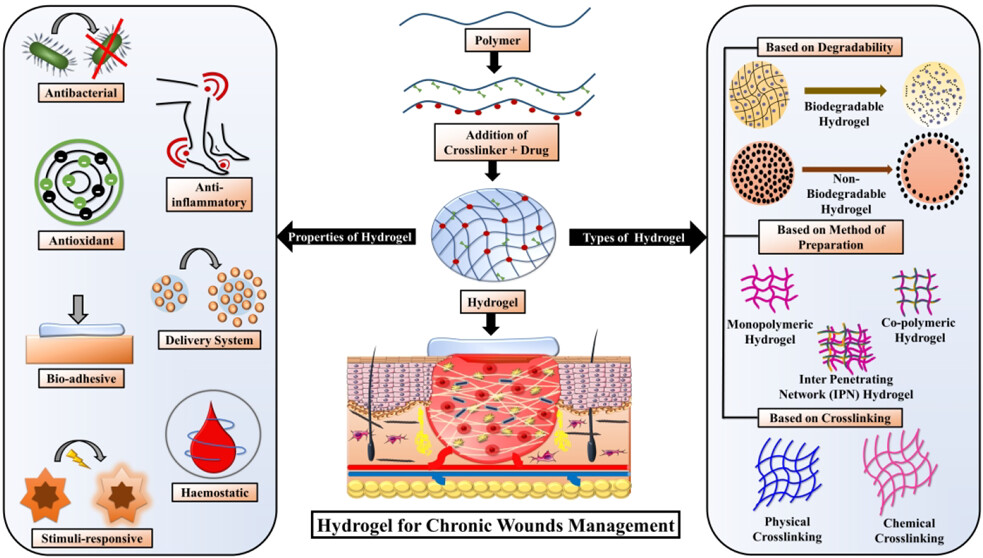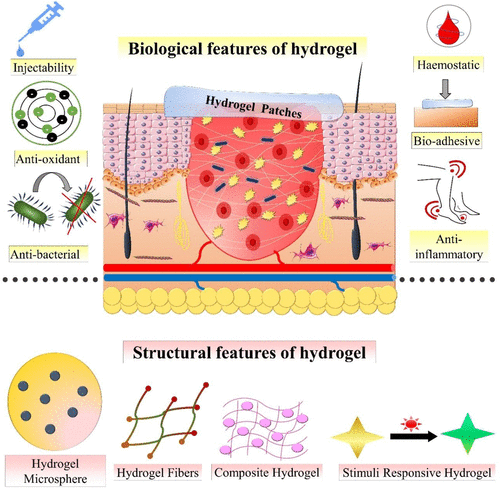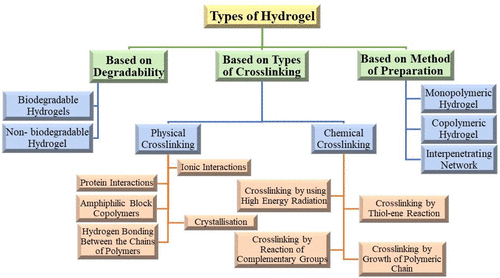
Privacy statement: Your privacy is very important to Us. Our company promises not to disclose your personal information to any external company with out your explicit permission.

 November 27, 2023
November 27, 2023
Wound healing is a complex and dynamic physiological process consisting of a series of cellular and molecular events that initiate immediately after a tissue lesion, to reconstruct the skin layer. It is indubitable that patients with chronic wounds, severely infected wounds, or any metabolic disorder of the wound microenvironment always endure severe pain and discomfort that affect their quality of life. It is essential to treat chronic wounds for conserving the physical as well as mental well-being of affected patients and for convalescing to improve their quality of life. For supporting and augmenting the healing process, the selection of pertinent wound dressing is essential. A substantial reduction in healing duration, disability, associated cost, and risk of recurrent infections can be achieved via engineering wound dressings. Hydrogels play a leading role in the path of engineering ideal wound dressings. Hydrogels, comprising water to a large extent, providing a moist environment, being comfortable to patients, and having biocompatible and biodegradable properties, have found their success as suitable wound dressings in the market. The exploitation of hydrogels is increasing perpetually after substantiation of their broader therapeutic actions owing to their resemblance to dermal tissues, their capability to stimulate partial skin regeneration, and their ability to incorporate therapeutic moieties promoting wound healing. This review entails properties of hydrogel supporting wound healing, types of hydrogels, cross-linking mechanisms, design considerations, and formulation strategies of hydrogel engineering. Various categories of hydrogel wound dressing fabricated recently are discussed based on their gel network composition, degradability, and physical and chemical cross-linking mechanisms, which provide an outlook regarding the importance of tailoring the physicochemical properties of hydrogels. The examples of marketed hydrogel wound dressings are also incorporated along with the future perspectives and challenges associated with them.

The wound healing process comprises four key phases, namely, (a) hemostasis, (b) inflammation, (c) proliferation, and (d) remodeling. A series of closely regulated events involving phagocytosis, chemotaxis, collagen degradation, nucleogenesis, and collagen remodeling exists within these key phases of wound healing. Moreover, a coordinated proliferation and migration of fibroblasts, keratinocytes, and other cell types are required to synthesize granulation tissue and thereby restore the epithelial layer.
Hydrogels are designed by using hydrophilic/hydrophobic polymers and cross-linking agents that have a strong affinity for aqueous media. Due to the hydrophilic nature of polymer and the porous and three-dimensional structure of hydrogel, it expresses a high rate of water absorption at the site of application. The cross-linking ability of the polar functional groups like amide, amino, carboxyl, and hydroxyl groups in the structure of the polymer is associated with the hydrophilic properties of hydrogels. Hydrogel is an ideal dressing candidate for wound healing owing to its properties such as high water content, bio-adhesiveness, biocompatibility, and malleability. Hydrogel demonstrates the swelling and deswelling property in aqueous solution; therefore, they are utilized in various fields such as regenerative medicine and drug delivery systems for the treatment of wounds. The moisture exchanging activities demonstrated by hydrogels help to attain an optimum microclimate between the dressing and the wound bed. This results in the promotion of the wound healing process in a more effective manner. The hydrogel dressings also provide a soothing, cooling effect and also lessen the pain allied with dressing changes, owing to their high moisture content. Furthermore, hydrogel dressings can be easily removed from the site of the wound without producing any type of additional damage to the healing tissue. The transparency of some hydrogels permits clinical evaluation of the wound healing process without removing it from the site of application. Recently, stimuli responsive hydrogels have been widely used for wound management as they provide controlled release and diffusion of the loaded bioactives. Some of the key properties of hydrogels making them an ideal wound dressing are described below and schematically represented in Figure below.

Classification of various types of hydrogels based on degradability, method of preparation, and types of cross-linking.

Involving several activities in a single wound dressing makes the regulatory and validation process more complex. Also, before smart hydrogels can be adopted routinely as delivery platforms for pharmacological agents, their clinical investigations are essential. Recent techniques of physical and chemical cross-linking such as amphiphilic block copolymers, crystallization, click chemistry, enzymatic reactions, etc. have expanded the scope of hydrogels’ applicability. The hydrogel’s future will move toward more specificity and lower costs. Attaining more effect on each phase of chronic wounds remains the key focus for forthcoming research. Some of the factors that are necessary to be optimized during hydrogel production are polymers solubility, stability, processability, and cross-linking materials. Bringing expertise from different fields, such as materials and biomedical engineering, chemistry, pharmacy, physics, etc., together to solve the current issues can be beneficial to improvise hydrogel as wound dressings.
References
1. Solanki D, Vinchhi P, Patel M M. Design Considerations, Formulation Approaches, and Strategic Advances of Hydrogel Dressings for Chronic Wound Management[J]. ACS omega, 2023, 8(9): 8172-8189.

Privacy statement: Your privacy is very important to Us. Our company promises not to disclose your personal information to any external company with out your explicit permission.

Fill in more information so that we can get in touch with you faster
Privacy statement: Your privacy is very important to Us. Our company promises not to disclose your personal information to any external company with out your explicit permission.